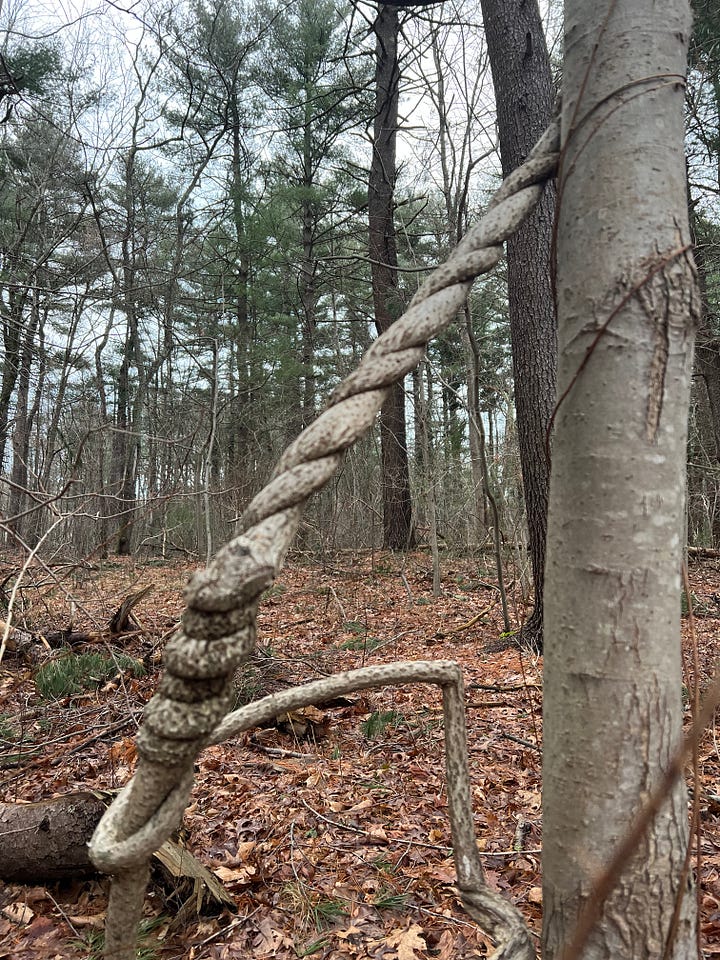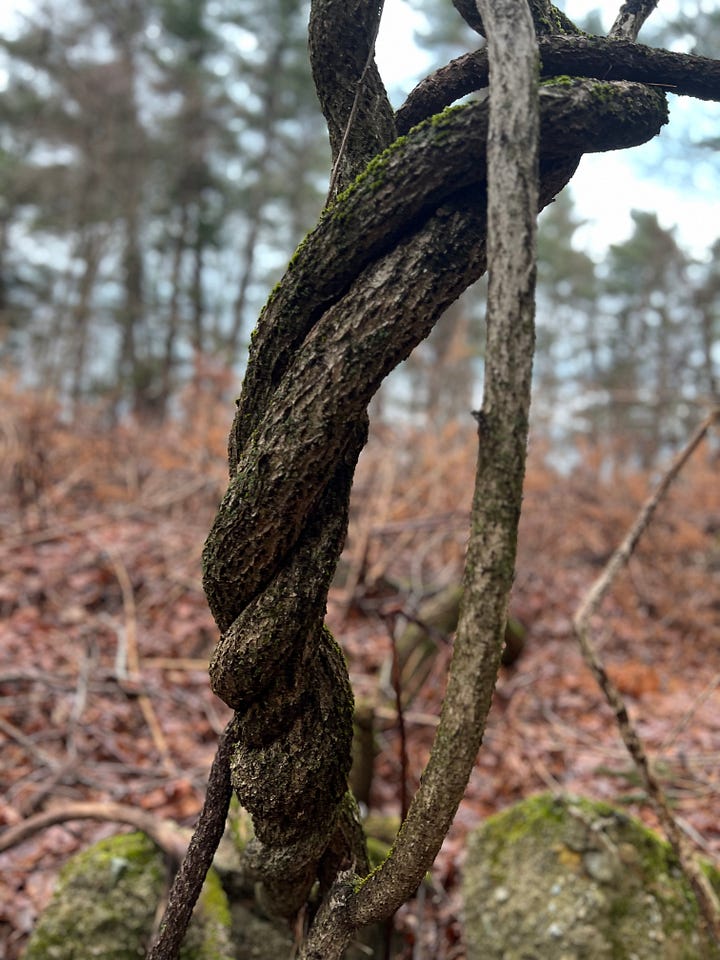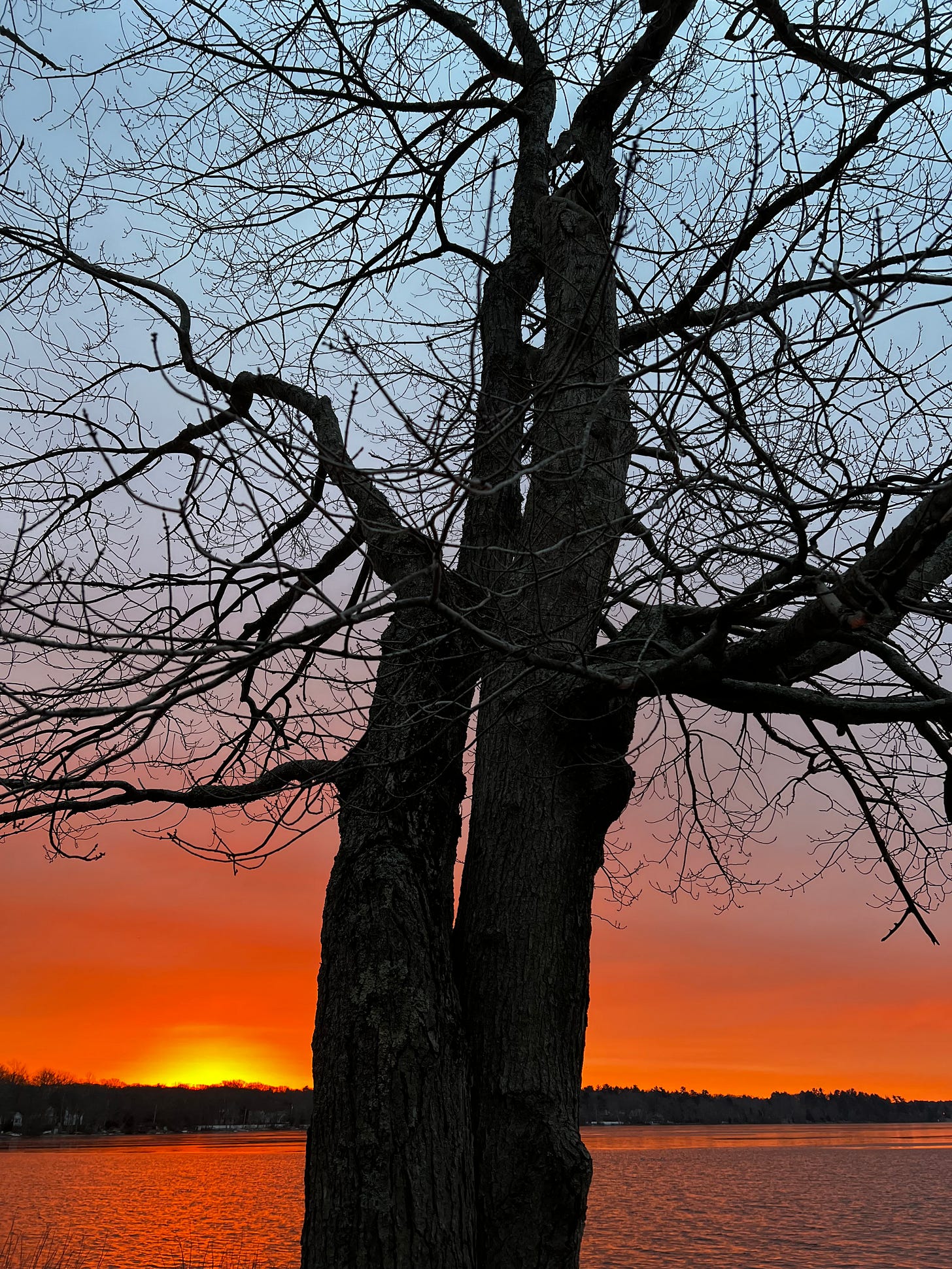This week’s newsletter is a braiding together of my meandering thoughts and some insights from of . Not only is Kristen a kick ass writer in recovery but she also happens to be an ISA certified Arborist.
As the year comes to a close, I’ve been thinking about how I want to enter 2025. In years past, I’ve picked a word of the year to serve as a compass. Last year I played with the idea of An Alphabet Atlas for the Year Ahead - 26 words to serve as guiding posts.
Right now, doing that again seems like a heavy lift. Right now, I’m finding comfort in the idea of restoration. Perhaps that will be my word for 2025.
I’m being pulled to this idea of recalibration and a return to some kind of factory setting. A kind of lifting of my hood to run internal diagnostics in an effort to help my engine purr again. Not so I can speed down the highway of productivity. More so I can downshift. Slow my roll. Idle and lay dormant.
In a spiritual sense, restoration is a transformative process. Unpacking past wounds, exposing them to the air so they can finally heal. Not ripping off the band aid. More of a slow unwrapping of a bandage that has felt like an appendage.
Because I like to nerd out on words, I looked up the etymology of the word:
restoration (n.)
late 14c., restoracioun, "a means of healing or restoring health, a cure; renewing of something lost," from Old French restoration (Modern French restauration) and directly from Late Latin restorationem (nominative restoratio) "a restoration, renewal," noun of action from past-participle stem of Latin restaurare (see restore).
What better time to renew than in the new year?
For me, this isn’t about resolutions or goals. I’m talking about restoring parts of me that feel long lost and forgotten.
This might look like opening a door to some shadow stuff. This might look like taking on things my younger self pushes me to do.
All of this has been bouncing around in my mind on my morning walks. It occurred to me that trees do this every year. Every winter they shed themselves in an effort to slowly unveil a revival in the next season. Nature’s restoration and renewal.
I’m discovering a fresh sense of appreciation for trees right now. My enthusiasm for them used to fixate on the vibrant array of colors from their leaves in the fall, especially here in New England.
Right now, though, perhaps for the first time, I’m recognizing how so much of the trees were hidden by all that foliage. Were they hiding from us all season until now? Is this actually the time they get to show their true magnificence? Wounds and all?
When the trees begin to drop their leaves, they are responding to the reality of darker and colder nights. The chlorophyll in the leaves recognizes it has had its fill, it has collected all it has to collect, and the chlorophyll which lends the green pigment is replaced by anthocyanins (red, purple, and crimson) or Carotenoids (yellow, orange, and brown) -- which brings forth the brilliant fall colors.
The leaves become crisp, and they fall as they want. Anyone who has blown a driveway knows this. They just keep falling.
I will say this about trees: the leaves fall when they choose to fall, at exactly the right moment, in response to its circumstances. The tree does not shake its own limbs. The leaf undergoes a process called abscission, wherein the leaf stem loosens, and the leaf falls, falls falls, exactly at the time it is meant to.
~Kristen Crocker
Maybe winter is the best time to drop all our pretenses. Let them fall to the ground, unmasking and revealing all the twisted roots of us. A stripping down to essentials.
Imagine if we humans were that in tune with releasing our grip. Could we be so vulnerable as to enter our own abscission? Maybe winter is the perfect time for us to release our clasp on all our colorful distractions. Why insist on cranking all our colors on full throttle 365 days a year?
Trees are just as bold in the winter. They may not exude all the brilliant autumn colors, but they show us all of themselves in isolation. They stand up there, bare boned with all of their limbs exposed, having shed what they normally hide behind. In their stripped-down simplicity, they reveal so much. They show us the core of themselves. The trees I thought I knew from frequent encounters I see now through fresh eyes.
I now can see all the homes birds built for their fledglings. Nests exposed to the sun.
The birds that stick around these parts in winter months I now see openly bouncing from branch to branch. The small winter songbirds with more space now to dance as they let out their notes.
Maybe it works the same way for humans. Perhaps if we unfold naturally into our own wintering, we’ll find a truer rhythm. Maybe we don’t need so much color either. We can trust the darker days. And know that there is actually great work being done by resting and turning down our daily hues. A muted restoration. Interpersonal pruning.
Kristen often informs her clients that the best time to prune is in the winter:
Major structural pruning is most advised in the winter, when the tree is dormant. The goal of structural pruning is to best allow the tree to compartmentalize the wound. Note that the tree never heals from the wound. The best it can do is to compartmentalize the wound, to protect the xylem and interior wood. The goal is to seal the wound, to shut the submarine door on the wound. To protect and preserve what remains.
I can’t help but think the same might be true for humans. That to protect and preserve ourselves this season we might have to shut the door on the world. If we allow ourselves to slow down as nature intends in the winter and expose our wounds, even if just up close to ourselves, the dormancy may bring clarity to us. Resting offers no guarantee that we will spruce right back up with vibrant gusto in the spring. We carry our wounds around in perpetuity I’m afraid. But perhaps laying down with them signals that you’re not afraid to prune away. Protect and preserve all of you - especially your tender wounds. The ones that feel raw from all the elements they were exposed to all year long. Those storms that life throws at you.
Restoration Pruning
A restoration prune most commonly occurs after a tree has been damaged -- by human intervention or by storm damage. The goal of a restoration prune is exactly that -- to restore the tree to its original form. This is typically reserved for historically or culturally significant trees.
The most common damage done to a tree that would require a restoration prune is topping. Topping most simply means reducing the height of the tree. Topping used to be common practice because there is no other way to reduce the height of a tree that had “gotten too tall near a house.” Well-meaning lumberjacks and tree people reduced the height of the tree, they thought, thereby reducing the risk.
At the point of topping, the tree has a stress response -- it recognizes its nutrient source has been attacked, so it attempts to produce as many leaves as possible at one time, sending out many shoots. From one knot might come six or seven sprouts.
A restoration prune would seek to remove some of the sprouts bushing out at that primary knuckle, the ones that gave it their best effort, to allow the most successful sprout to thrive. The goal would be for the sprout to eventually fully attach back to the main stalk -- to fully reattach as one single stalk. To return to nearest its original form. As is the case with all pruning, a tree never fully recovers from the wound -- but it tries its damndest to survive and thrive.
~Kristen Crocker
Isn’t that what we are all doing here? Trying our damndest to survive and thrive. The crooked branches of trees remind me that it’s ok to feel twisted up sometimes. We, too, can get mangled as a result of human topping - executed by people who try to keep us down, clipping away at us insisting they know what’s best.
Let’s give ourselves permission to let that perfect posture go occasionally. In winter, we can hunker down and fold into ourselves to burrow. Let’s perform topping on ourselves this season. Fight the urge to propel ourselves straight up in perfect lines day after day.
And when we do topple from life’s topping, let’s do what trees in the wild do - lean on one another in seasons of lack. Offer a hand in braided support. Take a look outside and you’ll be reminded that we are all interconnected.


Nature is handing us all one big permission slip to lean into the winter in grounded grace. If our limbs feel heavy in the long dark night, may we let them hang and lay quiet. Trusting that we’ll know when the time is right for reaching back up towards the light.

Thank you for all your knowledge and input here this week! Everyone should go check out Kristen’s Substack
Recoverettes
Normalizing recovery from alcoholism among strong, smart women through neuroscience, Twelve Step, woo-woo, and embracing anything that works for you.
TURNING TO YOU:
~I recently heard the expression, "nature is healthcare”. How will you nurture your nature and yourself this winter?
~What does internal pruning mean to you? How do you find restoration?
If you're a writer on Substack and have been enjoying my work, please consider recommending DARE TO BE to your readers. It’s a place where we practice living into our days by slowing down, exploring sobriety, and tapping into our collective creativity and curiosity.
If you’re a reader on Substack and have been enjoying my work and have someone in mind who you feel would welcome this space, please consider sharing this essay and my publication with them. It would mean so much.
Thank you for reading DARE TO BE. If you enjoy these essays from the heart and would like to show your support, please consider becoming a supporting member for only $5 a month.
If you enjoy essays that love on nature as our classroom, you may enjoy this one I posted in October.
My Permission Stick
I have a complicated relationship with stillness. I’m not talking about in my body. It’s my mind that is noisy, bouncy and persistent. It often feels like a pin ball machine up there.









I love this look at the impact of winter on trees and our souls. When he was four, my grandson asked me what will happen when I die. I told him that, like a tree, I will lose my leaves and have a rest, then I will come back like a tree in the springtime. Now, he tells me, "Omi, when you are a tree, I will visit you." Out of the mouths of babes. He didn't skip a beat in seeing me as a tree and found such solace in that picture of death and rebirth. Trees are amazing! So are young children. I'm looking into having a memorial tree planted in the park, when the time comes.
I love what trees can teach us. I was taught long ago to meditate with trees - to choose a tree and take a question to it, then sit quietly and wait to hear a response. Trees offer so many metaphors for living through witnessing how they live. I have heard many a wise answer from sitting with a tree 💚